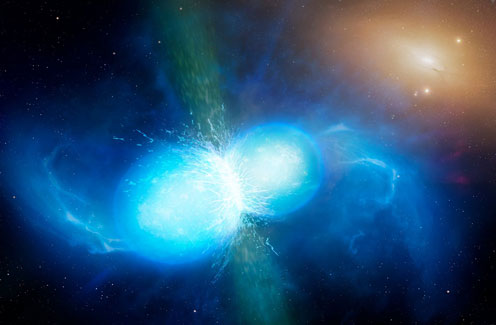Science and Physics World Breakthrough of the Year 2017
Science Breakthrough of the Year 2017 in the highly acclaimed publications, Science and Physics World, goes to the collaboration that led to the first ever observation of gravitational waves. The result is also on the list of the scientific magazine, Nature, ‘Science events that shaped the year’. An international team of physicists and astrophysicists took part in the work, which ushers a completely new era in astronomy.
The discovery can not only help explain how heavy elements are formed and spread in galaxies. It also points to a new method of measuring the distances to remote celestial bodies, because when astronomers have both gravitational waves and light to work with, they can measure remote distances more precisely. Based on the distance measured, they can calculate how fast the universe expands.
Researchers from several research sections at the Niels Bohr Institute have contributed to the global collaboration and can claim their part in the high ranking on the breakthrough lists. DARK Cosmology Centre (DARK), Discovery Center, Cosmic Dawn Center (DAWN) and Theoretical Particle Physics and Cosmology have led and participated in no less than 21 scientific articles in the wake of the observations of the collision between two neutron stars, and the gravity waves it sent through the Universe, simultaneously emitting observable light from the event.
The fact that this particular breakthrough is the winner of the prize is no surprise. “It is fundamental science and utterly exciting to be part of”, Professor Jens Hjorth from DARK says. When events this big take place in the universe, a large scientific network goes to work, directing the Earth based telescopes and satellites towards the correct location in the Universe. But they can only see a tiny portion of the sky at any given time. The IceCube Neutrino Observatory is unique in the manner that it makes measurements continuously across the sky, and is consequently able to help point out the initial starting point of such events, when neutrinos are involved.
With participation, either as first author or coauthors, in 21 of app. 100 articles on the subject pt., the University of Copenhagen is, with the scientists of the Niels Bohr Institute, exceptionally well represented in the Science Breakthrough of the Year by Science and Physics World.
Articles published by the Niels Bohr institute:
- Abbott et al.
Multi-messenger Observations of a Binary Neutron Star Merger:
2017ApJ...848L..12A
- Abbott et al.
A gravitational-wave standard siren measurement of the Hubble constant:
2017Natur.551…85A
- Albert et al.
Search for High-energy Neutrinos from Binary Neutron Star Merger GW170817 with ANTARES, IceCube, and the Pierre Auger Observatory: 2017ApJ, 850L, 35A
- Coulter et al.
Swope Supernova Survey 2017a (SSS17a), the Optical Counterpart to a Gravitational Wave Source: 2017, Science
- Covino et al.
The unpolarized macronova associated with the gravitational wave event GW 170817: 2017NatAs...1..791C
- Drout et al.
Light Curves of the Neutron Star Merger GW170817/SSS17a: Implications for R-Process Nucleosynthesis:2017, Science
- Evans et al.
Swift and NuSTAR observations of GW170817: detection of a blue kilonova: https://arxiv.org/abs/1710.05437
- Gall et al.
Lanthanides or Dust in Kilonovae: Lessons Learned from GW170817: 2017ApJ...849L..19G
- Gompertz et al.
The Diversity of Kilonova Emission in Short Gamma-Ray Bursts: 2017, ApJ in press
- Hjorth et al.
The Distance to NGC 4993: The Host Galaxy of the Gravitational-wave Event GW170817: 2017ApJ...848L..31H
- Kasen et al.
Origin of the heavy elements in binary neutron-star mergers from a gravitational wave event: https://arxiv.org/abs/1710.05463
- KilPatrick, et al.
Electromagnetic Evidence that SSS17a is the Result of a Binary Neutron Star Merger: 2017, Science
- Kim et al.
ALMA and GMRT Constraints on the Off-axis Gamma-Ray Burst 170817A from the Binary Neutron Star Merger GW170817: 2017ApJ...850L..21K
- Levan et al.
The Environment of the Binary Neutron Star Merger GW170817: 2017ApJ...848L..28L
- Marguia-Berthier et al.
A Neutron Star Binary Merger Model for GW170817/GRB 170817A/SSS17a: 2017ApJ…848L..34M
- Pan et al.
The Old Host-galaxy Environment of SSS17a, the First Electromagnetic Counterpart to a Gravitational-wave Source: 2017ApJ…848L..30P
- Pian et al.
Spectroscopic identification of r-process nucleosynthesis in a double neutron-star merger: 2017Natur.551…67P
- Shappee et al.
Early Spectra of the Gravitational Wave Source GW170817: Evolution of a Neutron Star Merger: 2017 Science
- Siebert et al.
The Unprecedented Properties of the First Electromagnetic Counterpart to a Gravitational-wave Source: 2017ApJ…848L..26S
- Smartt et al.
A kilonova as the electromagnetic counterpart to a gravitational-wave source: 2017Natur.551...75S
- Tanvir et al.
The Emergence of a Lanthanide-rich Kilonova Following the Merger of Two Neutron Stars: 2017ApJ...848L..27T
Videnskab.dk also chooses the most important scientific breakthroughs every year, and you can get an overview of their candidates here , as well as vote for your favorite. Gary Shaffer from Niels Bohr Institute and Olaf Pepke Pedersen from the Technical University of Denmark won last year, and this year the observations of the neutron star and the gravitational waves is among the nominees.

